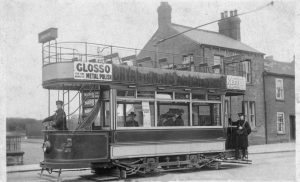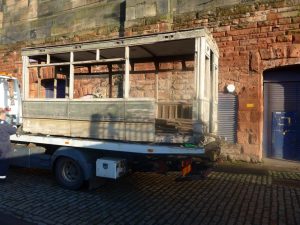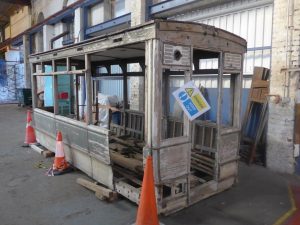THE LAST REMAINING CARLISLE TRAM BODY
The Trust is the proud owner of the last remaining body of a Carlisle tram. This is just the body which is in need of much TLC – no glass, no metalwork, no truck, and no electrics!
Carlisle’s Trams

On 30th June 1900 the Carlisle Tramway system opened, only two years after receiving Royal Assent. It was built by the City of Carlisle Electric Tramway’s Company, Limited and had 7¼ route miles of track to a gauge of 3 ft 6 ins, narrower than standard gauge railway lines. A bespoke Tram Shed was built in London Road and it still stands to this day. The lines ran from the town centre, north across Eden bridges to Stanwix and down Etterby Street stopping just before a humpback bridge across a beck. The road is very wide at the point where the Trams terminated.
Development
Heading out east the line ran down Warwick Road as far as the River Petteril where the Carlisle Steam Laundry could be found, who used to advertise their services on the Tram tickets. Two lines headed out west from the city centre. One went into Caldewgate past Carr’s Biscuit Factory. At shift change large numbers of Trams used to line up ready to take the workers home. The line went up Newtown Road past the Cumberland Infirmary and terminated at the junction with Shady Grove Lane. The other line went into Denton Holme terminating at North Street. There was one problem; a low railway bridge crossed the road. This bridge was only high enough for single decker Trams to pass under so could be very restrictive to the number of people that could be carried. There were numerous factories in this part of town and it was a very busy area.
Going south from the city centre down Botchergate the line split into two one going towards Currock across St Nicolas’s Bridges, which crossed the main southbound railway lines, terminating at Boundary Road. The other line continued down London Road, past the Tram shed and terminated near Gallows Hill. Not all of the lines authorised in the Act were built, these mostly being short extensions to those built, i.e. Etterby Street to the Scaur.
Uncertain times
Having got off to a good start, things went downhill and the system did not make a profit, and by 1910 a lack of maintenance was resulting in regular failures around the system. The company was sold at a loss to Balfour Beatty who basically renewed the whole system and bought twelve new Tramcars from the United Electric Car Company of Preston. It is not known what happened to the original ones.
The original trams were painted in chocolate-brown and cream but in 1912 the new cars started to appear in green and cream lined out in cream and red. The First World War again saw maintenance neglected and the council raised their concerns. This resulted in repair work starting in 1918. Things did not really get better as private buses started to appear in the city in greater numbers. They served the outlying villages as well as the new suburbs that were springing up around the city causing major congestion. In 1926 there were moves afoot for changes to public transport in Carlisle but it was not until early 1930 that the council and Tram company held talks about the future, however in December it was announced that the Ribble Bus Company of Preston were to take over the Tram system and replace it with buses, bringing an end to Trams in Carlisle on 21 November 1931 after just 31 years, or did it?
Disposals
The Tramway was torn up and the car bodies were sold for use as summer houses or farm outbuildings. They went far and wide, with number 8 ending up at Nenthead in the high Pennines, along with several others. Number 8 was eventually taken to the National Tramway Museum at Crich, in Derbyshire, to be used as a donor for the restoration of Gateshead and Leicester Trams based there. One car was known to be in the garden of a house at Scotby.
A discovery
In 1982 there was a report in the Cumberland News about a couple of Tram bodies being removed from a bungalow in Rosely. One was beyond saving but the other was in better condition having been used as a bedroom. Ambrose McCourt purchased the Tram and it was moved on a number of occasions, including back to the Tram Shed in London Road. There is a report that Tullie House obtained the Tram in 1985 from Ambrose. It was reported in 1986 that it had been purchased by the City Council ‘to save it from imminent destruction’. At some time the Tram was moved from the Tram Shed and was stored in a council depot in Bitts Park before it went to Carlisle College who placed it in their Swifts Mews building. They had planned to restore it as part of a woodworking class but for some reason the senior management did not support the venture.

In 2005 the College contacted the widow of Ambrose, Mrs M Sanderson, and asked her to remove the Tram. Tullie House claimed that as they had not formally accepted it they did not own it and that she did. The Tram was put up for auction on Sunday 21 August 2005, with great hopes, but it failed to sell. No individual or group in Carlisle was interested in saving the Tram so step forward our Trust. We agreed to make a donation to the charity of Mrs Sanderson’s choice in return for taking ownership. The college plans then changed so the Tram stayed where it was until, in 2013, it had to move again. With the help of Colin Glover the then Labour Leader of the City Council it went to Carlisle Railway Station Undercroft.
Restoration starts – then another move
For various reasons restoration did not go ahead as planned but in early 2020 a fresh start was made with the purchase of wood and the cutting of the first piece in the week of the first ‘lockdown’. Work had to stop. In October notice to move the Tram out of the Undercroft was received by the Trust. More wood was purchased and good progress was made, sufficient for the Tram to be moved safely to a new home.
Offers to provide a home came in from Kirkbride, Appleby, Sunderland and Blackpool. We also had offers to take it to turn into a glamping pod and one to restore it to provide a vintage Tram service on The Wirral. Fortunately Wayne McKnight came forward and offered the Tram a home in the old ironworks building in Denton Holme, in the city. With expert help from Jacksons Recovery Services the Tram was successfully moved on Wednesday 25 November, only two days later than the original date that it should have vacated the Undercroft, but as we were back in lockdown, for the second time, not bad going really.
Which Tram do we own?
This has been the subject of debate over the years. An ‘expert’ visited after he said that he could identify any Tram in the country. He failed. We know that it is one of the 1912 batch as they had only three windows per side. It is not number eight so must fall into either Nos 1-7. We have looked at every bit of wood that we have removed and those bits we didn’t need to but can’t find a number unfortunately, unless of course you know better?

What of the future? The current plan is to continue with the replacement of rotten wood and missing metal bits. This will allow the Tram to be painted and lined out in its original colours. We need a chassis if further restoration is to take place and we know that there are some available at Crich. They will not release one until we can show that we are serious about our restoration. It is also known that a couple of the original upper deck Tram seats are still in existence and these could be borrowed to make masters so that new castings could be produced. A couple of spiral staircases, more woodwork and, Bob’s your uncle, a complete Tram – but then what?
Big hopes
Well that was about as far as I thought but Coin Glover thought even bigger than me! Turn the Tram shed into a museum and the adjoining Railway Goods shed into a railway museum, highlighting how important the railways have been to Carlisle for over 150 years. Reinstate the Tram tracks along London Road and into the Courts area of English Street. Just think of tourists coming out of the station to see a Tram across the road that will take them to the museums and back after a suitable visit. Pie in the sky? Well think back to what was done for the Millennium and what continues to be done with National Lottery money for railways and museums around the country. It CAN be done. Just needs the will of a few determined people to get the ball rolling. Could you help? We need people to help with the restoration, woodworking, metalwork, cleaning and sanding then painting and varnishing. In addition of course we will needs funds to purchase the items needed for the restoration as well as covering the £150 it cost to move it to its new home.

Written by Philip Tuer, December 2020. Contact Phil on 01228-522118 or Philip.tuer@virgin.net
Any donations towards the work will be gratefully received at: WTHT, 22 Calva Road, Seaton, Workington CA14 1DF
